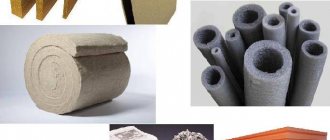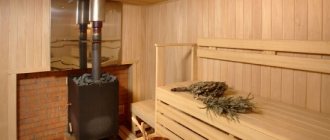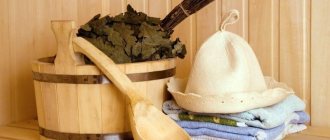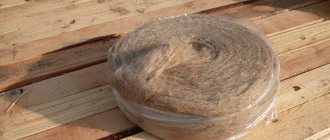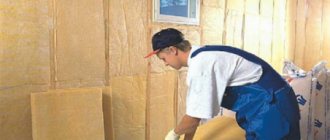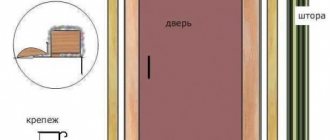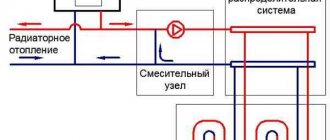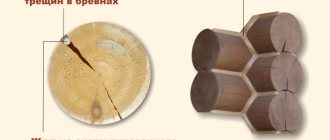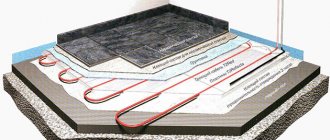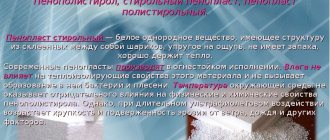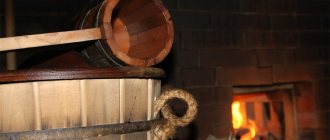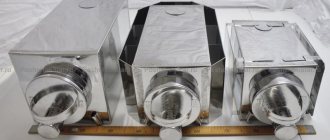From time immemorial, the Russian bathhouse was considered a place of cleansing, treatment and renewal of the body and was created only from natural materials. The modern world dictates its own rules: the depletion of natural resources and the high cost of natural materials forces the construction of baths from alternative raw materials.
Construction is only half the battle: it is important to preserve precious heat. For this purpose, baths are insulated. At the same time, the process of insulating a bathhouse is mistakenly considered simple. After all, the specifics of the structure require different insulation in certain areas.
Floor
The insulation process should begin at the most important stage of construction, which is the thermal insulation of the floor. To do this, it is worth pouring a layer of slag or expanded clay onto the base soil. The height of the poured layer should be twice as thick as the wall.
Scheme of floor insulation in a bathhouse
A reinforced expanded clay concrete screed is laid on the insulating layer, on which ceramic tiles are subsequently laid. In addition to expanded clay and slag, it is possible to use polymer materials as floor insulation, among which glass wool is effective and popular.
Practical tips for insulating a bathhouse ceiling
Bathhouse floor thermal insulation diagram.
1/3 of the total amount of heat lost in the bathhouse escapes through the ceiling of the room, so it needs insulation. Thermal insulation materials of low quality should not be used for work. The main indicator of their unsuitability is humidity. It is not recommended to lay insulation on an unprepared surface.
The ceiling in the bathhouse is mounted in such a way as to completely eliminate the formation of condensed moisture on its surface. Fiberboard, plywood and plastic are not suitable for installing bathhouse ceilings. When carrying out work on insulating the ceiling in a bathhouse, the following principles are observed:
- the presence of effective waterproofing, several times higher than that in a sauna;
- concentration of the entire volume of moisture under the ceiling.
It is unacceptable to insulate the ceiling in a cinder block bathhouse in the same way as in a sauna: steam dissipates in the steam room.
Experts recommend covering the ceiling with wooden slats 6 cm thick. For work, it’s a good idea to have the following materials and tools:
- wooden masher;
- drying oil;
- foil;
- knife;
- glue gun;
- saw;
- paper;
- clay;
- expanded clay;
- axe;
- hammer;
- glue;
- stapler;
- mineral wool.
A vapor barrier layer is laid on the wooden blocks with which the ceiling is sheathed. The materials used for it are foil, paper, and cardboard. Another clay coating is made on top. Insulation made of expanded clay, mineral wool, and sawdust impregnated with clay is attached to the ceiling. The layer has a thickness of no more than 15 cm.
Thermal insulation is covered with cement mortar, which is used to screed. Fiberboard is placed on glass wool insulation to reduce the movement of cold air masses.
Another insulation option is possible. To work you need to purchase materials:
- boards 5 cm thick;
- lining;
- cardboard;
- clay;
- basalt insulation;
- polyethylene film.
Insulation of the ceiling begins with lining it with boards 5 cm thick. A lining ceiling is laid on top of the supporting board. In this case, it is necessary to leave gaps for free air circulation.
Perform a vapor barrier: place a layer of thick cardboard on top of the boards. It is coated with a solution of clay with the addition of sawdust. The thickness of the layer is 3 cm. Basalt insulation about 15 cm thick is laid on top. It is covered with plastic film, which prevents the penetration of cold air. Attic boards are mounted on top of the beams.
Internal insulation
The structure of cinder blocks is porous, which allows for excellent heat retention, but the same porous surface absorbs moisture. Therefore, maximum protection of the walls eliminates the accumulation of moisture inside the blocks.
Before insulation, the internal walls of the bathhouse are lathed with wooden slats at least 50 mm thick, on which a layer of mineral wool, basalt insulation, polystyrene foam or any other material is laid. The thermal insulation layer is covered with foil film or aluminum foil, which performs the function of waterproofing. Particular attention should be paid to the tightness of the joints of all layers.
As the most effective way to insulate a bath, experts recommend vapor barrier with polypropylene foam, which is covered with aluminum foil. The ability of this material to withstand heat up to 150°
Aluminum foil is used as a material for insulating seams. If such insulation is insufficient, it is possible to lay one layer of non-combustible mineral wool between the wall and the vapor barrier layer.
How to insulate a cinder block bathhouse yourself from the inside?
As a building material for a bathhouse, cinder block has long established itself as a reliable and economical option. Its porosity and the presence of voids provide an air layer, which helps retain heat in the room for up to several days, provided there is good thermal insulation.
But such walls will only be durable if they have high-quality external and internal protection from moisture, because the blocks can absorb it in large quantities. Since this structure initially has a “wet” purpose, the question of how to insulate and finish a cinder block bathhouse from the inside is especially important.
You shouldn’t skimp here, because with all the costs of insulation, such a bathhouse still remains the most budget-friendly.
Today's generation of insulating materials makes it possible to reliably protect all surfaces that need protection from heat transfer and moisture. The developer makes a choice based on finances, the time allotted for construction, environmental friendliness, thermal conductivity and the structure of insulators. An important criterion in the choice is fire resistance, since the presence of a stove makes the bathhouse a place of increased fire danger. However, most thermal insulators lose their properties when wet, so the second important issue here is the absolute waterproofing of surfaces.
The materials for internal thermal insulation of a bathhouse are usually the following: glass wool, mineral wool, polymers (for example polystyrene foam). It should be noted that many polymers are very toxic and release toxic substances as they heat up, so it is better to give preference to more expensive and safe types of insulation. For waterproofing, foil-clad propylene, aluminum foil and aluminum tape are used. Sand, expanded clay and slag filling will be needed to insulate the floor at the initial stage of construction.
Warm floor in the steam room
Work on thermal insulation of the floor begins already in the process of laying the foundation. Initially, it is important to make important engineering decisions that will ensure the drainage of water from the steam room and washing room. To reduce heat transfer through the floor, it is necessary to eliminate the possibility of freezing of the soil under the bathhouse at the very beginning. This problem is solved by using expanded clay concrete screed on the ground. A fairly easy insulation option: it does not require special skills, but that’s not all that needs to be done.
The next step on the path to a warm floor is to warm it up. Naturally, the floor won’t just warm up, but we have a stove and we can use it. To do this, a special insert is made into the combustion chamber of the furnace, with an air supply regulator. This inset is lowered below floor level. In this case, the stove can take cold air from under the floor, and the already heated air will descend in its place. By ensuring such circulation, we will simultaneously get rid of unpleasant odors that may accumulate in the underground.
Insulation of bath walls
Work with the walls inside a cinder block bathhouse begins with securing a 100% moisture-proof coating (simple rolled polyethylene will do) and lathing it with wooden slats of the required thickness. Use bars slightly smaller than the thickness of the insulation.
The pitch between the slats should be such that the distance between them is less than the selected insulation, then it will adhere tightly. The thickness of the insulation layer depends on the characteristics of the material and the climate. Glass wool is used from 10 cm. We attach isolon on top of the bars. The insulation is installed and moisture-resistant plywood of small thickness is placed on top of it.
It is attached to the bars using a stapler. You can put a layer of aluminum foil on top of the plywood. The foil is responsible for the dryness of the insulation and walls, i.e. in this case, for the reliability of the entire structure. All joints should be carefully taped with aluminum tape to avoid possible gaps.
For additional insulation of the steam room, foiled polypropylene is used - this measure pumps heat exactly where it is needed. This insulation can then be finished with clapboard or other materials of your choice.
Bathroom ceiling insulation
When installing a ceiling in a bathhouse, it is necessary to take into account not only the fact that it accounts for up to a third of heat loss, but also the fact that the accumulation of condensate on the surface reduces any insulation measures to nothing. Therefore, vapor barrier from the inside is required here much more than for walls, actually coming to the fore. This type of work in this case requires much more effort than a similar one in a sauna.
Initially, it is recommended to cover the ceiling with hewn and dried boards 40 mm thick. The wider the boards you can find, the more beautiful they will look, no matter what type they are. Even with knots, it will be even more beautiful. It is not advisable to use clapboard; it may move. Large thickness of boards is not desirable due to the accumulation of a large amount of cold during periods of absence of heat.
This leads to the appearance of condensation on the ceiling while heating the steam room. A layer of waterproofing must be placed on them; this can be a regular greenhouse film or other vapor barrier material. Everything can be covered with a 15 cm layer of dry sawdust or put mineral wool and covered with ordinary clay on top. This is a very good method that our grandfathers used.
We invite you to familiarize yourself with do-it-yourself formwork for the foundation of a bathhouse
If it is glass wool, then an additional fiberboard plate is placed on it.
Preference has always been on the side of wood. It is convenient, hygienic, and easy to replace if necessary. Not to mention that different types of wood have different healing effects on the human body, and their very atmosphere is an integral part of traditional bath culture.
The tree must be one that is not capable of overheating and causing a burn to a person. For the interior decoration of the steam room, initially only deciduous varieties were used: ash, alder, birch, poplar, larch, aspen, linden. Resinous types of trees and any conifers are unsuitable for interior finishing.
- The material must be in the required condition. The lining must spend at least a day in climatic conditions comparable to bathhouses. Otherwise, it may dry out to cracks (if it is too wet) or swell (if it is dry), which will greatly deteriorate its appearance and performance properties.
- Nail thin slats onto the finished thermal insulation with a pitch corresponding to the width of the finishing panels. Use stainless nails (bronze, copper). The best way is to assemble the panels into a groove.
- Always mount the lining in the steam room horizontally - this will allow you to easily change the lower beams as they wear out, which will prolong the operation of the sauna for a long time.
- Wood is best suited for flooring. Any synthetic coating is poisonous at bath temperatures and is therefore not suitable. It is not advisable to use oak - it is slippery and therefore dangerous. In addition, it has a low heat capacity. It is possible to install heated floors in the dressing room and rest room.
If you approach the construction and decoration of a bathhouse creatively and wisely, then more than one generation of lovers of paired procedures will delight with its unique design and therapeutic warmth.
Many owners of country plots dream of having their own bathhouse. But putting up a log house is quite expensive. The solution to this issue is to build bathhouse walls from cinder blocks - this is much cheaper and faster in terms of construction time.
In order for such a bathhouse to keep warm for a long time, it must be insulated with modern materials. Moreover, such work must be carried out not only from the outside, but also from the inside. We will focus on insulating a cinder block bathhouse in this article.
Today, several types of insulation are used to insulate cinder block buildings (including bathhouses):
- Mineral insulation consists of various wools, for example, stone, slag or basalt. They have excellent heat resistance and high thermal insulation properties. They are produced in soft rolls and pressed slabs of varying hardness.
- Plastic based insulation. This class includes almost all thermal insulation materials with the prefix “foam”: polystyrene foam, polyurethane foam and other modern insulation materials. A distinctive feature of foam materials is their light weight, excellent moisture resistance and high thermal insulation properties.
- Organic materials are also popular for their environmental friendliness and excellent properties. The most popular natural insulation materials are: jute felt, flax batting, flax tow, particle boards with the addition of special additives.
Advice! To insulate horizontal surfaces (floor and ceiling) of cinder block baths, bulk materials with high thermal insulation characteristics are used: expanded clay or sawdust.
For high-quality and reliable thermal insulation, a whole range of insulation measures is required. That is, insulating the walls alone will not bring a tangible result - all surfaces must be sheathed from the inside with heat-insulating material. Let's take a closer look at the entire technology of insulating a bathhouse from the inside.
Floor insulation
The process of floor insulation begins almost immediately after the completion of the construction of walls and installation of the roof. You can save a lot on floor insulation if all the construction waste remaining after masonry is poured into the foundation pit and compacted thoroughly. Here it is important not to overdo it and leave about 50 cm for insulation.
In order to efficiently and reliably insulate the floor, you need to adhere to the following sequence of work:
- It is necessary to level the subfloor a little (with small construction waste, sand or earth) so that the insulation layer is uniform.
- Then expanded clay is poured into the space under the foundation. It is recommended to use it because it has high thermal insulation properties and excellent strength. The minimum layer should be 20–25 cm, more is possible.
- Expanded clay must be compacted thoroughly. You can spill it with water and let it sit for a few days to dry.
- Then a reinforcing mesh is laid on top of the expanded clay.
- The next step is pouring the cement mortar. Its thickness should be at least 10–15 cm.
- In the process of pouring the mortar, you need to follow the technology of a conventional screed: carefully level and smooth the surface, since this will be a subfloor.
Finishing
The final finishing can be done with wooden paneling or any other materials, taking into account the wishes and capabilities of the owner. Thin wooden slats are applied to a layer of waterproofing, foil film or aluminum foil, onto which the finishing material is attached. Experts recommend installing wooden lining horizontally in order to be able to replace the lower individual layers - over time, under the influence of moisture, they can become unusable.
External insulation
Cinder blocks with a porous structure quickly lose their properties without proper cladding, so you should not skimp on insulation. For external insulation, lining, siding or block house are often used, which are attached to wooden blocks fixed directly to the walls of the bathhouse.
In any case, special attention should be paid to creating an air gap. In this case, the layer of air between the materials will serve as a heat insulator. Some experts recommend insulating a bathhouse using plaster, but this method is labor-intensive and less effective.
Ventilated facade
The most reliable way to insulate a bathhouse is the ventilated facade method. Before starting work, brackets in the form of corners should be secured to the walls, and the space between the brackets should be narrower than the width of the seal.
Ventilated facade of a bathhouse using aerated concrete as an example. In a cinder block bathhouse, installation is carried out in the same way.
Between the metal corners we reinforce mineral wool mats. We seal the connecting joints with special tape. A waterproofing layer fixed to mineral wool mats will protect the insulation from moisture. After this, you can install additional fasteners for the final cladding of the facade. Glass wool or polystyrene foam can be used as insulation materials for exterior work.
How to insulate a cinder block bathhouse from the outside
Is insulation necessary?
Expanded clay concrete blocks are a rather controversial material that has significant advantages and the same disadvantages.
One of the most obvious is its hygroscopicity, which is completely inappropriate in a room with high humidity. This is explained by the fact that in severe frosts, blocks of expanded clay concrete saturated with moisture will freeze and collapse.
The Russian bathhouse does not lose its popularity, and at the same time it must be built in compliance with the relevant norms and rules. Therefore, the question of how to insulate a bathhouse remains very relevant.
Proper thermal insulation of the bathhouse will help to significantly reduce fuel costs, improve the quality of the procedure, and keep the building itself in good condition for a long time, especially if the bathhouse is used all year round.
Since ancient times, Russian baths have been insulated using natural materials - moss, tow, bast, etc. Nowadays, it is better to use artificial insulation. They are durable, easy to install, and environmentally friendly.
When choosing insulation, it is necessary to take into account the peculiarities of using bath rooms - high levels of moisture, high temperatures, and often live fire. All these points impose certain requirements on bath insulation, especially if they will be used for internal insulation.
Before purchasing material, it is necessary to carefully consider a number of important factors, taking into account cost, biological inertness, and technical characteristics of the proposed heat insulators. Another important point is the regional climate. The amount of materials required is determined by the size of the bathhouse building and the required thickness of the thermal insulation layer.
Whether it is necessary and whether it is possible to insulate a bathhouse from the outside depends on the material from which it is built, the regional climate and the time of use - seasonal or year-round.
In order to carry out thermal insulation of a bathhouse yourself, you need to prepare the following set of tools:
- construction tape;
- screwdriver;
- building level and plumb line;
- axe;
- chisel;
- saw or hacksaw;
- hammer;
- jigsaw;
- wire cutters or pliers;
- sharp technical knife;
- electric drill or hammer drill.
In addition to the insulation itself, for work you will need:
- vapor barrier film;
- wooden beam;
- metal rail;
- screws and nails;
- adhesive tape.
The bathhouse usually has: a dressing room, washing rooms, a steam room, a dressing room, and a relaxation room. These rooms have different levels of humidity and temperature during washing. Therefore, how you can insulate a bathhouse inside is determined for each room separately.
According to their mechanical characteristics, insulation materials are divided into bulk, block and tile, matte and fibrous materials.
We invite you to familiarize yourself with Insulating a bathhouse ceiling with natural materials. Advantages and installation features
The chemical composition makes it possible to divide heat insulators into organic, inorganic, technical and plastic materials.
Plastic-based heat insulators are best used for insulating rooms with low levels of moisture and temperatures. They are not used in the steam room due to their easy flammability and deformation when heated. Cheap and safe organic heat insulators can be used in a steam room only after fire prevention treatment.
Inorganic heat insulators are considered the most practical. These materials are fire resistant and non-hygroscopic. They do not rot and can serve for a long time without losing their basic technical properties.
The most successful vapor barrier option for all sauna rooms is aluminum foil. It is fire-resistant, durable, non-hygroscopic. The main advantage of aluminum foil is its ability to reflect heat. By using such a vapor barrier in a bathhouse, you can significantly reduce the consumption of fuel material.
Glassine and roofing felt cannot be used in the steam room, since these materials, when heated, emit volatile toxic substances. In some cases, glassine can be used as insulation. It is better not to use roofing material for this purpose at all.
The choice of insulation and the method of its installation depend on the material from which the bathhouse is built. If the bathhouse is built from timber, a cellular sheathing of timber is first installed on the load-bearing walls. The cross-section of the timber should be 0.2-0.3 cm greater than the thickness of the heat insulator. This will ensure the safety of the insulation and its useful properties.
The selected heat insulator is placed between the sheathing beams. It is covered with a vapor barrier material. The vapor barrier is laid with a shift. A thin metal strip is mounted over the joints. A gap of no more than 3 cm must be left between the insulation and the vapor barrier.
The corners of the room, pipes, window and door openings are sealed using special vapor barrier tape. This will protect problem areas from moisture penetration.
For finishing in this case it is easier to use clapboard boards. It is stuffed on top of the vertical sheathing.
Bath buildings of panel or frame type are insulated only with heat insulators that have a low specific gravity. Before use, they are treated with lime milk to protect against corrosion and increase fire resistance. After processing, the material must be thoroughly dried.
We insulate the steam room
The steam room in the bathhouse requires special attention. After all, it is here that the highest level of moisture and elevated temperature are observed during operation. Therefore, insulation, waterproofing and finishing of this room must be done with special materials.
The ceiling of the steam room is subject to maximum heating during operation (up to 150 °C). Therefore, the question of how to insulate the ceiling of a bathhouse is solved by using materials with high heat resistance.
If there is no attic or attic, insulation is installed in the following order:
- wooden lattice made of timber on the ceiling boards;
- sheathing elements;
- thermal insulation;
- vapor barrier.
If there is an upper room - an attic, an attic - the insulation scheme looks slightly different. A layer of clay at least 2 cm thick is applied to the ceiling boards. This will ensure moisture retention. All small holes, joints between boards, etc. are filled with bulk material. Typically, expanded clay or wood chips are used for this. The thickness of this layer is at least 20 cm.
A box-shaped base of rafter supports is mounted on the ceiling around the chimney. This will provide a gap of 20 cm between the pipe and the heat insulator, required by fire safety. A non-flammable heat insulator such as glass wool or mineral wool is placed inside the box. The main surface of the ceiling is covered with a layer of mineral heat insulator.
